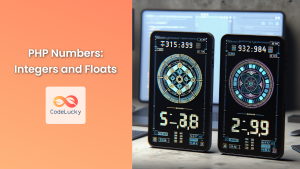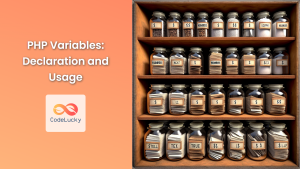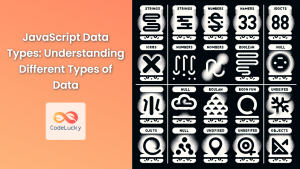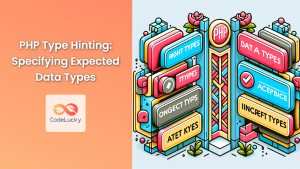PHP, as a versatile and dynamic programming language, offers a rich set of data types that allow developers to efficiently handle various kinds of information. Understanding these data types is crucial for writing robust and efficient PHP code. In this comprehensive guide, we'll explore the different data types available in PHP, their characteristics, and how to use them effectively in your projects.
Scalar Types
Scalar types are the most basic data types in PHP. They represent single values and are the building blocks for more complex data structures.
1. Integer
Integers are whole numbers without a decimal point. They can be positive, negative, or zero.
$age = 30;
$temperature = -5;
$count = 0;
echo "Age: " . $age . "\n";
echo "Temperature: " . $temperature . "\n";
echo "Count: " . $count . "\n";
Output:
Age: 30
Temperature: -5
Count: 0
💡 Fun Fact: The maximum value for an integer in PHP depends on your system. On 32-bit systems, it's typically 2,147,483,647, while on 64-bit systems, it can go up to 9,223,372,036,854,775,807.
2. Float (Double)
Floats, also known as doubles, are numbers with a decimal point or in exponential form.
$pi = 3.14159;
$avogadro = 6.022e23;
$tiny = 1.0E-10;
echo "Pi: " . $pi . "\n";
echo "Avogadro's number: " . $avogadro . "\n";
echo "A very small number: " . $tiny . "\n";
Output:
Pi: 3.14159
Avogadro's number: 6.022E+23
A very small number: 1.0E-10
⚠️ Warning: Be cautious when comparing float values due to potential precision issues. Use functions like bccomp() for accurate comparisons.
3. String
Strings are sequences of characters, enclosed in single or double quotes.
$name = "Alice";
$greeting = 'Hello, World!';
$mixed = "I'm 25 years old.";
echo $name . "\n";
echo $greeting . "\n";
echo $mixed . "\n";
Output:
Alice
Hello, World!
I'm 25 years old.
🔍 Pro Tip: Use double quotes when you need to include variables or escape sequences within the string.
4. Boolean
Booleans represent truth values: either true or false.
$isLoggedIn = true;
$hasPermission = false;
var_dump($isLoggedIn);
var_dump($hasPermission);
if ($isLoggedIn && !$hasPermission) {
echo "User is logged in but doesn't have permission.";
}
Output:
bool(true)
bool(false)
User is logged in but doesn't have permission.
🎭 Interesting Tidbit: In PHP, many values are automatically converted to booleans in a boolean context. For example, 0, empty strings, and null are considered false, while non-zero numbers and non-empty strings are true.
Compound Types
Compound types allow you to store multiple values in a single variable.
1. Array
Arrays in PHP are ordered maps that can hold multiple values of any type.
// Indexed array
$fruits = ["apple", "banana", "cherry"];
// Associative array
$person = [
"name" => "Bob",
"age" => 35,
"city" => "New York"
];
// Multidimensional array
$matrix = [
[1, 2, 3],
[4, 5, 6],
[7, 8, 9]
];
echo "First fruit: " . $fruits[0] . "\n";
echo "Person's name: " . $person["name"] . "\n";
echo "Matrix[1][1]: " . $matrix[1][1] . "\n";
// Using print_r for better array visualization
print_r($fruits);
print_r($person);
print_r($matrix);
Output:
First fruit: apple
Person's name: Bob
Matrix[1][1]: 5
Array
(
[0] => apple
[1] => banana
[2] => cherry
)
Array
(
[name] => Bob
[age] => 35
[city] => New York
)
Array
(
[0] => Array
(
[0] => 1
[1] => 2
[2] => 3
)
[1] => Array
(
[0] => 4
[1] => 5
[2] => 6
)
[2] => Array
(
[0] => 7
[1] => 8
[2] => 9
)
)
🚀 Power Move: Use the array_map() function to apply operations to all elements of an array efficiently.
2. Object
Objects are instances of user-defined classes, allowing for more complex data structures and behaviors.
class Car {
public $brand;
public $model;
public $year;
public function __construct($brand, $model, $year) {
$this->brand = $brand;
$this->model = $model;
$this->year = $year;
}
public function getInfo() {
return "{$this->year} {$this->brand} {$this->model}";
}
}
$myCar = new Car("Toyota", "Corolla", 2022);
echo $myCar->getInfo() . "\n";
var_dump($myCar);
Output:
2022 Toyota Corolla
object(Car)#1 (3) {
["brand"]=>
string(6) "Toyota"
["model"]=>
string(7) "Corolla"
["year"]=>
int(2022)
}
🏆 Best Practice: Use objects to encapsulate related data and behaviors, promoting better code organization and reusability.
Special Types
PHP also includes special types for specific use cases.
1. NULL
NULL represents a variable with no value.
$emptyVar = NULL;
$undefinedVar;
var_dump($emptyVar);
var_dump($undefinedVar);
if (is_null($emptyVar)) {
echo "The variable is NULL\n";
}
Output:
NULL
NULL
The variable is NULL
⚡ Quick Tip: Use the isset() function to check if a variable is set and is not NULL.
2. Resource
Resource is a special type holding references to external resources, such as database connections or file handles.
$file = fopen("example.txt", "w");
echo "Resource type: " . get_resource_type($file) . "\n";
fclose($file);
$conn = mysqli_connect("localhost", "username", "password", "database");
echo "Resource type: " . get_resource_type($conn) . "\n";
mysqli_close($conn);
Output:
Resource type: stream
Resource type: mysqli
🔒 Security Note: Always remember to close resources (like file handles and database connections) when you're done using them to prevent resource leaks.
Type Juggling and Casting
PHP is loosely typed, which means it can automatically convert between types. However, you can also explicitly cast variables to specific types.
$number = "42";
$sum = $number + 8; // PHP converts the string to an integer
echo "Sum: " . $sum . "\n";
$forced = (int)"42.9"; // Explicit casting
echo "Forced integer: " . $forced . "\n";
$binary = (binary)"Hello"; // Convert to binary string
echo "Binary: " . bin2hex($binary) . "\n";
$float = (float)"3.14";
echo "Float: " . $float . "\n";
$array = (array)"PHP";
print_r($array);
Output:
Sum: 50
Forced integer: 42
Binary: 48656c6c6f
Float: 3.14
Array
(
[0] => PHP
)
🧙♂️ Magic Trick: Use the settype() function to change a variable's type without creating a new variable.
Checking and Comparing Types
PHP provides several functions to check and compare variable types.
$mixed = [42, "hello", 3.14, true, null, new stdClass()];
foreach ($mixed as $value) {
echo "Value: " . var_export($value, true) . "\n";
echo "Type: " . gettype($value) . "\n";
echo "Is integer? " . (is_int($value) ? "Yes" : "No") . "\n";
echo "Is string? " . (is_string($value) ? "Yes" : "No") . "\n";
echo "Is numeric? " . (is_numeric($value) ? "Yes" : "No") . "\n";
echo "Is null? " . (is_null($value) ? "Yes" : "No") . "\n";
echo "Is object? " . (is_object($value) ? "Yes" : "No") . "\n";
echo str_repeat("-", 30) . "\n";
}
Output:
Value: 42
Type: integer
Is integer? Yes
Is string? No
Is numeric? Yes
Is null? No
Is object? No
------------------------------
Value: 'hello'
Type: string
Is integer? No
Is string? Yes
Is numeric? No
Is null? No
Is object? No
------------------------------
Value: 3.14
Type: double
Is integer? No
Is string? No
Is numeric? Yes
Is null? No
Is object? No
------------------------------
Value: true
Type: boolean
Is integer? No
Is string? No
Is numeric? No
Is null? No
Is object? No
------------------------------
Value: NULL
Type: NULL
Is integer? No
Is string? No
Is numeric? No
Is null? Yes
Is object? No
------------------------------
Value: (object) array(
)
Type: object
Is integer? No
Is string? No
Is numeric? No
Is null? No
Is object? Yes
------------------------------
🔬 Deep Dive: The gettype() function returns a string representation of a variable's type, while type-specific functions like is_int() or is_string() return a boolean.
Conclusion
Understanding PHP data types is fundamental to writing efficient and error-free code. From basic scalar types to complex compound types, each serves a specific purpose in your PHP applications. By mastering these data types and their behaviors, you'll be better equipped to handle various programming challenges and create more robust PHP solutions.
Remember, PHP's flexibility with data types can be both a blessing and a curse. While it allows for quick development, it's crucial to be aware of type juggling and potential type-related issues, especially when dealing with user input or external data sources.
As you continue your PHP journey, experiment with different data types, explore their methods and behaviors, and always strive to use the most appropriate type for your specific use case. Happy coding! 🐘💻



















